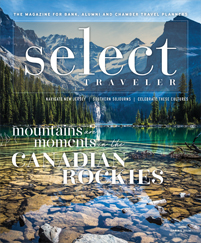As our group drove toward Wadi Rum, Jordan’s most celebrated desert, its sandstone mountains rose in the distance like sentinels. The closer we got to those mountains, the more stark their beauty became. On arrival, we jumped into open-air jeeps and began a half-day drive through a remarkable land.
Serrated peaks of red and pink sandstone jutted from the sand. The only shade in this relentless terrain comes in the shadows of its mountains. They offer relief in an otherwise unforgiving expanse.
Traveling with a dozen of this magazine’s readers at the invitation of the Jordan Tourism Board (JTB), I learned that this is a country influenced by spirituality everywhere you go. But in this region of Jordan, the desert projects a divinity all its own.
Wadi Rum, like the God of the Old Testament, is severe. Those who can see beauty in austerity and brilliance in the stars will find it to be among the best regions of Jordan. Many travelers already come to gaze into the heavens at night and see countless stars absent any ambient light.
“Wadi Rum is one of our most popular outdoor adventure destinations,” said Omar Banihani, one of our JTB hosts. “In the past couple of years, we have had the Columbia outdoor wear company, among others, come in to shoot catalogs here. To sit around a campfire at night and look into the sky is amazing. There is absolutely no light pollution whatsoever.”
We were not able to stay overnight; instead we enjoyed the comforts of Jordan’s Dead Sea resorts. But we did visit two of Wadi Rum’s overnight camps, Rahayeb and Captain’s Camp, where we enjoyed a wonderful outdoor lunch. These elaborate camps offer all the amenities a group needs for an overnight stay.
Cities Modern and Historic
Our trip began four days earlier in Amman, the cosmopolitan capital of Jordan. Amman is a medical center for the Middle East and a meeting place for international commerce. We enjoyed a boisterous introductory meal at Sufrah restaurant, where everyone began to get to know one another.
Afterward, we walked back to our coach along one of Amman’s narrow, busy streets. Due to our international flight, I was awake that morning around 5 when the Muslim call to prayer was broadcast throughout the city. It was melodic enough that I fell asleep again before it ended.
“Many travelers come here for bird-watching,” said our guide, Mahmoud Twaissi, on the coach the next morning. “I had a group here last week from the United Kingdom that spent 12 days watching birds. We have 80 species here. We are on their worldwide migration routes.”
We were on our way to Jerash, one of Jordan’s best Greco-Roman archaeological sites. Hadrian’s Gate, like other structures here, was built around A.D. 130, during Roman rule. The massive gate is the city’s best-known structure and features three arches. The larger one in the middle was for chariots and horses, while pedestrians used the outer two.
A large hippodrome with stadium seating for chariot races loomed to our left.
“Historians believe there were around 15,000 seats here during that time, and they estimate that Jerash had 40,000 inhabitants in the second century A.D.,” said Mahmoud.
Jerash’s ornate theater has seating sections like our theaters today, marked by Roman numerals still visible that indicated who was to sit where based on rank. Actors entered from elaborate backstage doors recessed into the stage.
“As a museum professional, I must say that Jerash was incredible,” said Dean Phelus, senior director of international programs and events for the American Alliance of Museums, afterward. Phelus was struck by Jordan’s archaeology: “Jerash is beautifully preserved,” he said.
“Jerash has Greco-Roman ruins that are comparable to any you’ll see in Turkey or Greece doing the footsteps of Paul,” said Mike Nieland, another group member, who owns Blue Marble Journeys in Ankeny, Iowa.
Baptism at Bethany
We spent our second day visiting several of Jordan’s acclaimed biblical sites. Our group became aware during this trip that a journey to the Holy Land is incomplete without visiting Jordan. The necessary border crossings between Israel and Jordan are simply part of the experience. The two signed a peace agreement in 1994 and have facilitated border crossings ever since.
We began at Bethany Beyond the Jordan, the site on the eastern side of the Jordan River where historians believe John the Baptist baptized Jesus. We were greeted by engineer Rustom Mkhjian of Jordan’s Baptism Site Commission.
“We began development of this site in 1997,” he said. “It could not be developed until we signed a peace agreement with Israel. Without that, we could not work here as archaeologists and theologians.
“Jesus tells us to build our house on a rock,” said Mkhjian, “so we have to be very careful to be correct in what we say about this site. John the Baptist started his ministry here. John was killed 35 miles southeast of here in Machaerus.
“Pilgrims throughout history have mentioned this site, and churches have been built here,” he continued. “Popes have visited this site; the last was Pope Francis this spring. This is the site where bridges of love and peace must be built.”
At the baptism site is a rudimentary wooden platform built along the river bank. On the opposite side is a more ornate structure in the West Bank. Pilgrims gather on both sides to wade into the river or be baptized.
“The Jordan River site left an indelible mark on me in my understanding of Christianity,” said Phelus. “Frankly, I had no idea I would have that experience. I also thought about those two countries that are divided by such a tiny river.”









